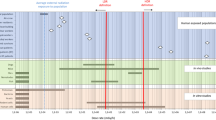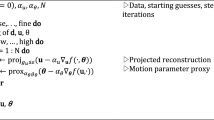Abstract
We consider a matrix decomposition problem arising in Intensity Modulated Radiation Therapy (IMRT). The problem input is a matrix of intensity values that are to be delivered to a patient via IMRT from some given angle, under the condition that the IMRT device can only deliver radiation in rectangular shapes. This paper studies the problem of minimizing the number of rectangles (and their associated intensities) necessary to decompose such a matrix. We propose an integer programming-based methodology for providing lower and upper bounds on the optimal solution, and demonstrate the efficacy of our approach on clinical data.
Similar content being viewed by others
References
Ahuja, R. K., & Hamacher, H. W. (2005). A network flow algorithm to minimize beam-on-time for unconstrained multileaf collimator problems in cancer radiation therapy. Networks, 45(1), 36–41.
Baatar, D., Hamacher, H. W., Ehrgott, M., & Woeginger, G. J. (2005). Decomposition of integer matrices and multileaf collimator sequencing. Discrete Applied Mathematics, 152(1), 6–34.
Boland, N., Hamacher, H. W., & Lenzen, F. (2004). Minimizing beam-on time in cancer radiation treatment using multileaf collimators. Networks, 43(4), 226–240.
Dai, J., & Hu, Y. (1999). Intensity-modulation radiotherapy using independent collimators: an algorithm study. Medical Physics, 26(12), 2562–2570.
Earl, M. A., Afghan, M. K. N., Yu, C. X., Jiang, Z., & Shepard, D. M. (2007). Jaws-only IMRT using direct aperture optimization. Medical Physics, 34(1), 307–314.
Engel, K. (2005). A new algorithm for optimal multileaf collimator field segmentation. Discrete Applied Mathematics, 152(1), 35–51.
Hamacher, H. W., & Küfer, K.-H. (2002). Inverse radiation therapy planning—a multiple objective optimization approach. Discrete Applied Mathematics, 118(1), 145–161.
Kalinowski, T. (2005). A duality based algorithm for multileaf collimator field segmentation with interleaf collision constraint. Discrete Applied Mathematics, 152(1), 52–88.
Kamath, S., Sahni, S., Li, J., Palta, J., & Ranka, S. (2003). Leaf sequencing algorithms for segmented multileaf collimation. Physics in Medicine and Biology, 48(3), 307–324.
Kim, Y., Verhey, L. J., & Xia, P. (2007). A feasibility study of using conventional jaws to deliver IMRT plans in the treatment of prostate cancer. Physics in Medicine and Biology, 52(8), 2147–2156.
Küfer, K.-H., Monz, M., Scherrer, A., Trinkaus, H. L., Bortfeld, T., & Thieke, C. (2003). Intensity Modulated Radiotherapy—a large scale multi-criteria programming problem. OR Spektrum, 25, 223–249.
Lee, E. K., Fox, T., & Crocker, I. (2000). Optimization of radiosurgery treatment planning via mixed integer programming. Medical Physics, 27(5), 995–1004.
Lee, E. K., Fox, T., & Crocker, I. (2003). Integer programming applied to intensity-modulated radiation treatment planning. Annals of Operations Research, 119, 165–181.
Men, C., Romeijn, H. E., Taşkın, Z. C., & Dempsey, J. F. (2007). An exact approach to direct aperture optimization in IMRT treatment planning. Physics in Medicine and Biology, 52(24), 7333–7352.
Nemhauser, G. L., & Wolsey, L. A. (1999). Integer and combinatorial optimization. New York: Wiley.
Preciado-Walters, F., Rardin, R., Langer, M., & Thai, V. (2004). A coupled column generation, mixed integer approach to optimal planning of intensity modulated radiation therapy for cancer. Mathematical Programming, 101(2), 319–338.
Romeijn, H. E., Ahuja, R. K., Dempsey, J. F., & Kumar, A. (2005). A column generation approach to radiation therapy treatment planning using aperture modulation. SIAM Journal on Optimization, 15(3), 838–862.
Romeijn, H. E., Ahuja, R. K., Dempsey, J. F., & Kumar, A. (2006). A new linear programming approach to radiation therapy treatment planning problems. Operations Research, 54(2), 201–216.
Shepard, D. M., Ferris, M. C., Olivera, G. H., & Mackie, T. R. (1999). Optimizing the delivery of radiation therapy to cancer patients. SIAM Review, 41(4), 721–744.
Taşkın, Z. C., Smith, J. C., Romeijn, H. E., & Dempsey, J. F. (2010, to appear). Optimal multileaf collimator leaf sequencing in IMRT treatment planning. Operations Research, 58(3), 674–690.
Author information
Authors and Affiliations
Corresponding author
Additional information
The work of H. Edwin Romeijn was supported by the National Science Foundation under grant No. DMI-0457394/CMMI-0852727.
Rights and permissions
About this article
Cite this article
Taşkın, Z.C., Smith, J.C. & Romeijn, H.E. Mixed-integer programming techniques for decomposing IMRT fluence maps using rectangular apertures. Ann Oper Res 196, 799–818 (2012). https://doi.org/10.1007/s10479-010-0767-1
Published:
Issue Date:
DOI: https://doi.org/10.1007/s10479-010-0767-1




